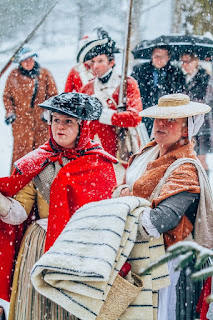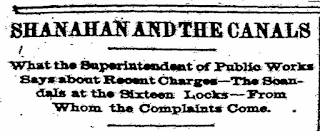 |
| Detail from a map of a portion of Westchester County NY showing fortifications and localities in the 1770s |
References to Valentine's Hill during the Revolutionary War might pertain to either of two different localities near the lower end of the Hudson Valley just north of Manhattan. Each was significant during this period, featuring maneuvers, skirmishes, and occupations from time to time by both Crown and Whig forces. Both were in what was then lower Westchester County. One site lies in the Bronx and refers to a hillside just North of the stone house owned during the war by Issac Valentine, and the other is just a few miles away in Yonkers and named for the family of Matthias Valentine (1698-1781), a freeholder whose leasehold of the property from Philipse Manor dates to 1720. Just to make things even more interesting, also Isaac Valentine was also originally from Yonkers, both men were apparently unrelated.
 |
| Detail from the Saultier map (1777) that misidentifies Mile Square |
Matthias Valentine's Hill
(Nearby localities: Valentine's Bridge, Mile Square, Mile Square Road, Tippett's Brook, Post's Hill, Saw Mill River, Philipses' Manor)
The eminence known as Valentine's Hill took its name from Matthias Valentine, whose grandsons Thomas and Gilbert lived here as tenants of the Philipse Manor during the Revolution. The area was contested territory deep within "The Neutral Ground" and was occupied at various times by each of the opposing forces. Col. Frederick Philipse was a staunch loyalist whose lands were confiscated in 1779. The Valentines subsequently acquired more than two hundred acres of Valentine's Hill in 1785 when the Philipse lands were broken up and sold. Today, Valentine's Hill is the site of St. Joseph's Seminary, which is bounded on the north by the Cross County Parkway and on the south and west by Valentine Street. Nearby, Mile Square Road echos that long forgotten settlement.
[Summer 1775] The summit of Valentine's Hill is entrenched for the first time with a hill fort that will be expanded and re-occupied at subsequent periods by both Whig and Crown forces.
[October 21- 22, 1776] George Washington made his headquarters with General Lincoln at "Valentine's at Mile Square" a week before the Battle of White Plains. His expenses were 20 dollars. While there, his correspondence included a letter to Elizabeth Williams Philipse, wife of the patroon. Elizabeth Valentine (1767 - 1854) is the source of an apocryphal account of a morning prayer lead by Washington with his staff.
[January 27, 1777] Once again making his headquarters at Valentine's Hill, General Benjamin Lincoln wrote:
" These may certify, that on or about the 25th day of October last, I ordered Thomas Valentine's one yoke of oxen and cart, to be taken for the public service. They carried a load to the White Plains. There I discharged them. I am informed they were further taken on their return, and that Mr. Valentine hath not received them."
[January 1778] William Erskine encamped on Valentine's Hill.
[August 31, 1778] The decimation of the Native American company of Stockbridge Militia that took place along the Mile Square road between Cortland's Woods and what is now Woodlawn cemetery in the Bronx. This was about midway between the two Valentine's Hills, and as Brigadier General Charles Scott's letter of that date to General Washington makes clear, the Stockbridge men marched south from Matthias Valentine's Hill prior to the ambush:
"...about 8 oClock this morning Colo. Gist Fell in with a partie of the enemy about two mile Below Philaps’s hous and after exchanging a fiew Shot they gave way leaving one killed Dead & Making three prisoners the Colo. Returnd to his Usial post without any loss—But I am sorry To inform Your Excellency that they retalliated on us in a Very fiew hours, Majr Steward with a partie of about forty, and Capt. Nimham with about the Same number parted at Volentines hill and appointed to meet at the forks of a road near the Enemys Picquet, but before or Rather about their meeting they saw a partie of horse In front after exchanging a fiew Shot the Horse Gave way the indians persued when they war led Into an ambucade Serounded by a large body of Horse and foot, as was also the Majrs partie there are not more than fourteen Indians Yet com in among the missing is Capt. Nimham his father and the whole of the officers of that Corps, Majr Steward tells me that he misses a Capt. Sub. & About twenty men from his partie, I am in Hopes it is not so bad as it at Preasant appears But I cant promise my self that it will be much Short of it..."
[September, 1778] During the Grand Forage, General Kyphausen deployed his forces between Philipse Hall and Valentine's Hill as shown on the following contemporary map.
[July 2-4 1781] Washington returns to Valentine's Hill and makes his headquarters here while the combined Franco-American forces encamp at Philipsburgh.
Isaac Valentine's Hill
(Nearby localities: Kingsbridge, Fort Independence, Boston Road; Negro Fort, Valentine's house, Williams' house, William's Bridge and Fordham Manor)
Isaac Valentine was a successful blacksmith and farmer from Yonkers who purchased his land on the Boston Road from the financially insolvent Dutch Reformed Church and build a two story stone house there in 1758. Isaac Valentine's family remained in residence during most of the war after an 11 months hiatus in 1776, but financial hardship in the early 1790's compelled him to sell his home and land to Isaac Varian. His house still survives and is the second oldest residence in the Bronx. It was moved in 1965 about 100 yards to its current location on the West side of the Williams Reservoir Oval as the home of the Museum of Bronx History at the Valentine-Varian House.
[1/17/1776] A large number of American field pieces that had been stockpiled in Valentine's fields and on adjacent Williams' lands were spiked or "loaded with stones and other rubbish" by local Tories. More than 82 guns were unspiked in the following months. [Edsell, T.H.: History of the Town of Kingsbridge (1887) pg. 23].
 |
| Portion of a map from October, 1776 prepared for General Sullivan by Alexander Scammell [Fort Independence is Number 11 on the map, and "Volentine's" lies to the East] |
"Our Comp’y was then stationed at Delancy’s Mills for a month or longer, and while we were there we were attacked by the enemy in the month of January or February, and driven back to Valentine’s Hill where we had an action. Our Compy was the only compy stationed at the Mills, but several other companies were stationed at or near the Hill. The attack at the Mills was very sudden and we had hardly time to escape leaving our packs and baggage behind us. When we reached the Hill we met the other troops where a stand was made. Genl Wooster commanded during the engagement, and soon commanded a retreat to the Hollow, where we formed and brought up some field pieces to bear on the enemy when they retreated. One from our compy, Levi Smith was killed in this action. After the action our Compy were stationed for a few days at Valentine’s Hill, and then returned towards Saw Pits... [Pension S.15721"
[August 26, 1777] The Orderly Book of Delancey's (Loyalist) Brigade contains the following entry:
 |
| Detail from A Map of the Country Adjacent to Kingsbridge (1781) Prepared for General Clinton |
[July 21-23,1781] During the Grand Reconnaissance, in which a combined American and French force considered an attack on Manhattan, General Rochambeau found accommodation on July 22, 1781 at Issac Valentine's House. The allied forces briefly occupied territory that included Isaac Valentine's Hill and stretched from Fort Independence to Williams Bridge and south to Delancey's Mills.
There are still some episodes from the war that require further confirmation before determining to which Valentine's Hill they refer. One of these is contained within the memoirs of General Heath, who recorded on September 16, 1782:
"The enemy made a grand forage near Valentine's Hill; Sir Guy Carlton was out in person, as was the young prince [William Henry]. The covering party, it was said, consisted of 5 or 6,000 men."


















